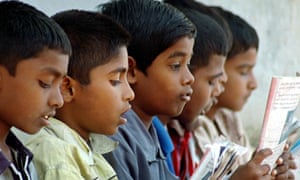 Menu
MenuAbsent teachers, lack of incentives and low standards force Indians, rich and poor, into the private sector

Armal Ali lives in one of the poorest neighbourhoods of Lucknow, the capital ofUttar Pradesh, India. The family of 11 occupy a breeze-block shack with no windows. Ali works all day at a hand loom, sitting cross-legged on the ground, making embroidered saris that are highly prized across the subcontinent. But local residents know too well that such work wrecks eyesight and causes chronic backache.
Ali hopes that his daughter Ousma, 9, will lead a different life. "Nothing special," he says, "but at least sitting at a desk, for instance, with plenty of light around her." He would also like her to speak English, like "the people in suits who talk about money all day on television".
But when her father fell ill, Ousma had to leave her private school, as the family could no longer pay the fees. There was no free state school nearby.
Increasing numbers of Indians, rich and poor, are paying for schooling. The share of pupils in private education has risen from 28% to 33% in just three years. In rural areas it has almost doubled in eight years, from 16% to 29%.
Private schools organise classes in tiny rooms, sometimes outside. Even if rain means lessons are cancelled, it is still better than a class without a teacher, as is often the case in state schools where teachers are absent one day in five, on average.
This statistic sums up the learning crisis that, according to many researchers, now threatens development in India, where half the population of 1.27 billion is under 25.
The Annual Status of Education Report, carried out in rural areas by the non-governmental organisation Pratham, reveals that though enrolment is still high, at over 96% (a free mid-day meal is a major incentive), pupils do not learn a great deal. After three years 60% of them still cannot read, except for their first name maybe, compared with 54% four years ago.
A Right to Education Act, passed in 2010, requires all children aged six to 14 to attend school but pays little attention to what they learn when they are there. The act is more like an architect's brief, specifying the minimum dimensions of classrooms and playgrounds.
So how does one recognise a good school in the impoverished countryside of Uttar Pradesh? For one thing it should be near a road, enabling teachers to get there by car … quickly, if they find out an inspector plans to visit.
In a little village in the district of Sitapur the primary school is deserted, but for dogs and livestock. One of the out-buildings is used for storing hay. We found the teacher sitting outside in the sun, reading the paper, with the few remaining pupils serving him tea.
Ali Ahmad is an assistant teacher and his job mainly involves child-minding. He earns about $55 a month, 10 times less than a qualified primary schoolteacher and without the job security. "The teacher doesn't often come, because he lives in the town, a long way from here. So it's up to me to do the teaching," Ahmad explains.
In Uttar Pradesh teachers enjoy a higher standard of living than most people, roughly 10 times the per capita GDP in the state. But this may be the root of the problem. "Such a high pay could be counterproductive, attracting the wrong kind of people," Esther Duflo and Abhijit Banerjee, both professors at the Massachusetts Institute of Technology, wrote in a recent article in the Indian Express, particularly as "there is no obvious reward for performance" and "children are promoted automatically".
Parents in one village we visited in Utter Pradesh prefer to pay around $1.20 a month to one of the many nearby private schools. To begin with, five or six children had private tuition under a tree with a retired teacher. A few years later there were about 160 of them, studying in various shacks. "At least we have a timetable. The kids know beforehand whether they'll be doing maths or reading, and the teachers are here every day," the head proudly explains.
The experts recommend reforms, such as grouping pupils according to their grade, rather than age, or streamlining the syllabus.
When Ousma left her private school in Lucknow she enrolled at an education centre set up by Pratham, where she has lessons in a small group of comparable level. In just a few months she learned to read and write, and now dreams of becoming a teacher.
This article appeared in Guardian Weekly, which includes material from Le Monde
http://www.theguardian.com/world/2014/mar/11/india-education-state-private-school